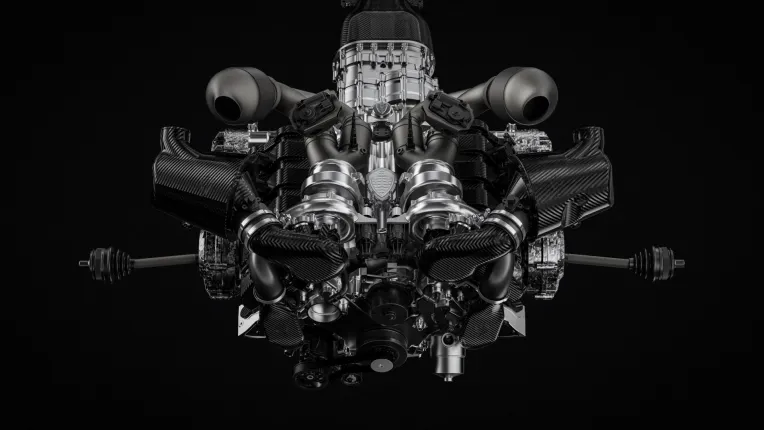In March 2020, just before the world was plunged into the uncertainty of a global pandemic, Koenigsegg unveiled a groundbreaking addition to their lineup: the Gemera.
This four-seater Mega-GT model not only showcased the company’s ingenuity but also redefined what hypercars could be.
Featuring a 2.0-liter, 3-cylinder hybrid system, the Gemera was poised to revolutionize the automotive industry with its staggering 1,700 hp and 3,500 Nm of torque.
The Birth of the Gemera: A Vision Realized
Introducing the Mega-GT Concept
The Gemera’s introduction was a bold move for Koenigsegg, known for their two-seater hypercars like the Agera and Regera.
The Mega-GT concept aimed to combine the performance of a hypercar with the practicality of a grand tourer, making it the first of its kind.
Christian von Koenigsegg, the company’s visionary founder and CEO, emphasized the importance of innovation and pushing boundaries, and the Gemera embodied this philosophy.

A Powertrain Unlike Any Other
At the heart of the Gemera lies a twin-turbo 2.0-liter three-cylinder engine, equipped with Freevalve technology. This advanced system allows for precise control of the engine’s intake and exhaust valves, leading to significant improvements in efficiency and performance.
The petrol engine alone produces 600 bhp and 600 Nm of torque, driving the front axle.
The hybrid system is completed by three electric motors, delivering an additional 1,100 bhp. Each rear wheel has its own motor, while the third motor is integrated on top of the engine crank.
This setup not only provides immense power but also ensures excellent handling and stability through all-wheel drive, four-wheel steering, and torque vectoring.
Production Challenges and Market Response
The 2.0-Liter Hybrid vs. the V8
While the 2.0-liter hybrid powertrain was a technological marvel, the market response was tepid. Despite its impressive specifications, potential buyers were more intrigued by the alternative powertrain option Koenigsegg presented later: a traditional 5.0-liter V8 twin-turbo engine.
This beast of an engine produces 2,300 hp and 2,750 Nm of torque, with 1,500 hp coming from the V8 and 800 hp from an electric motor.
Market Preferences and Strategic Decisions
The preference for the V8 was so overwhelming that Koenigsegg faced a tough decision. Few customers opted for the 2.0-liter engine, leading the company to convince these buyers to switch to the V8.
This strategic move was necessary to avoid the complexities and costs of producing both powertrains. Despite the initial disappointment, Christian von Koenigsegg remains committed to the hybrid technology, hinting that it might still find a place in the Gemera or future models.

Engineering Mastery: Features and Specifications
Advanced Aerodynamics and Design
The Gemera’s design is a testament to Koenigsegg’s dedication to blending form and function. The car features a sleek, aerodynamic silhouette with large dihedral synchro-helix doors, allowing easy access to the spacious four-seater cabin.
The extensive use of lightweight materials like carbon fiber ensures that the Gemera remains agile despite its larger size.
Interior Comfort and Luxury
Inside, the Gemera offers a level of comfort and luxury rarely seen in hypercars. The cabin is designed to accommodate four adults comfortably, with ample legroom and headroom.
High-quality materials, advanced infotainment systems, and customizable options make the interior both luxurious and functional.
Cutting-Edge Technology and Safety
Safety and technology are at the forefront of the Gemera’s design. The car comes equipped with advanced driver-assistance systems, including adaptive cruise control, lane-keeping assist, and automatic emergency braking.
Additionally, the infotainment system integrates seamlessly with various devices, providing a connected and intuitive driving experience.
The Future of the Gemera: Production and Beyond
Production Timeline and Expectations
Koenigsegg plans to begin production of the Gemera in late 2024, with the first deliveries expected in 2025. The anticipation surrounding the Gemera is palpable, as it represents a significant step forward for the company and the hypercar segment as a whole.
The production model will likely retain the stunning performance and innovative features that made the concept so exciting.
Potential Impact on the Automotive Industry
The Gemera’s introduction has the potential to influence the broader automotive industry. By combining extreme performance with everyday usability, Koenigsegg is challenging the traditional notions of what a hypercar can be.
This blend of practicality and performance could inspire other manufacturers to explore similar concepts, leading to a new wave of innovative vehicles.
Christian von Koenigsegg’s Vision for the Future
Commitment to Innovation
Christian von Koenigsegg’s commitment to innovation is unwavering. Despite the market’s initial preference for the V8, he remains dedicated to developing the hybrid powertrain.
This dedication to pushing the boundaries of technology and performance is what sets Koenigsegg apart from its competitors.
Expanding the Koenigsegg Legacy
The Gemera is more than just a new model; it’s a symbol of Koenigsegg’s evolution. As the company continues to expand its lineup and explore new technologies, it remains focused on delivering unparalleled performance and innovation.
The Gemera is a testament to this commitment and a preview of what’s to come.
Conclusion: The Gemera’s Place in Automotive History
The Koenigsegg Gemera is poised to make a lasting impact on the automotive world. With its unprecedented combination of performance, practicality, and innovation, it represents a new era for hypercars.
As production begins and the first models hit the road, the Gemera will undoubtedly cement its place in automotive history as a groundbreaking and visionary vehicle.




































